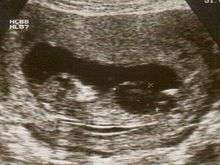Megacystis (fetal)
Fetal megacystis[1] is a rare disease that is identified by an abnormally large or distended bladder.
| Megacystis (fetal) | |
|---|---|
| Specialty | Urology |
Cause
Megacystis is associated with Berdon syndrome (MMIH syndrome).[2]
Diagnosis

Fetal megacystis is diagnosed during pregnancy by ultrasound imaging procedures. Since it can be associated with genetic abnormalities, further ultrasounds and tests may be administered during pregnancy. It may also be diagnosed as megalocystis, and/or termed megabladder, which is the same condition.
Megacystis is listed as a rare disease by the Office of Rare Diseases (ORD) of the National Institutes of Health (NIH), which means it affects fewer than 200,000 people within the U.S.
Treatment
Megacystis can often be treated pharmacologically or with biofeedback to improve bladder functioning, if the child survives past early infancy.[2]
See also
References
- Taghavi, K.; Sharpe, C.; Stringer, M. D. (February 2017). "Fetal megacystis: A systematic review". Journal of Pediatric Urology. 13 (1): 7–15. doi:10.1016/j.jpurol.2016.09.003. ISSN 1873-4898. PMID 27889224.
- Petrikovsky, Boris M. (1999). Fetal Disorders: Diagnosis and Management. John Wiley & Sons. p. 143. ISBN 9780471191520.